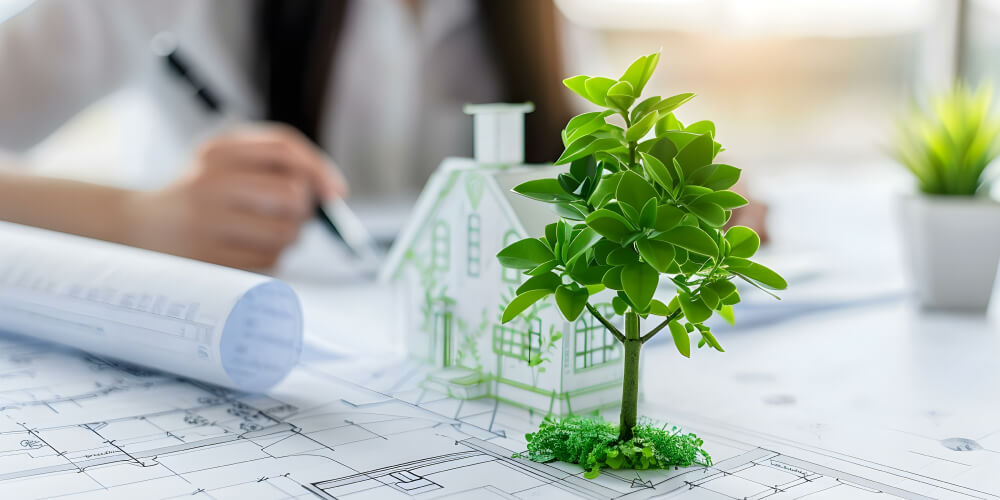1. Energy Efficiency
Reduced Energy Consumption:
- Natural Heating: Passive solar design captures and stores solar energy to naturally heat your home, reducing the need for conventional heating systems.
- Natural Cooling: By strategically placing windows, shading devices, and using thermal mass, passive solar design helps keep your home cool in the summer, reducing the need for air conditioning.
Lower Utility Bills:
- Cost Savings: By reducing reliance on heating and cooling systems, passive solar design lowers your energy consumption and utility bills.
- Long-Term Savings: The initial investment in passive solar features pays off over time with consistent energy savings, making it a cost-effective renovation choice.
2. Enhanced Comfort
Consistent Indoor Temperatures:
- Thermal Mass: Materials like concrete, brick, and tile absorb and store heat during the day and release it at night, maintaining stable indoor temperatures.
- Solar Gain: South-facing windows maximize solar gain during the winter, providing natural warmth and reducing the need for artificial heating.
Improved Indoor Air Quality:
- Natural Ventilation: Passive solar design often incorporates natural ventilation strategies, such as cross-ventilation, to improve indoor air quality and reduce humidity levels.
- Reduced Pollutants: By minimizing the use of mechanical systems, passive solar design reduces the circulation of dust and allergens, creating a healthier indoor environment.
3. Environmental Benefits
Reduced Carbon Footprint:
- Lower Emissions: By decreasing reliance on fossil fuels for heating and cooling, passive solar design reduces greenhouse gas emissions, contributing to a lower carbon footprint.
- Sustainable Living: Embracing passive solar principles supports sustainable living and promotes environmental stewardship.
Conservation of Resources:
- Energy Efficiency: Passive solar design maximizes the efficient use of natural resources, reducing the strain on local energy grids and conserving resources.
- Renewable Energy: Utilizing solar energy is a renewable and inexhaustible resource, reducing dependence on non-renewable energy sources.
Join HICP Homeowner’s Alliance
Connect with experts, get special discounts and enjoy member benefits
4. Increased Property Value
Market Appeal:
- Eco-Friendly Features: Homes with passive solar design features are attractive to environmentally conscious buyers looking for energy-efficient and sustainable properties.
- Higher Resale Value: The energy savings and environmental benefits associated with passive solar design can enhance the resale value of your home.
Aesthetic Appeal:
- Natural Light: Strategically placed windows and skylights bring in natural light, creating a bright and inviting living space.
- Architectural Design: Passive solar design often incorporates modern and innovative architectural elements, enhancing the overall aesthetic appeal of your home.
5. Key Elements of Passive Solar Design
Orientation and Layout:
- South-Facing Windows: Positioning the majority of windows on the south side of the house maximizes solar gain in the winter and minimizes it in the summer.
- Open Floor Plans: Open floor plans facilitate the even distribution of heat and natural light throughout the home.
Thermal Mass:
- Heat Storage: Incorporate materials with high thermal mass, such as concrete, brick, or stone, to absorb, store, and release heat efficiently.
- Flooring Choices: Use tile, stone, or concrete flooring to enhance thermal mass and improve energy efficiency.
Insulation and Air Sealing:
- High-Quality Insulation: Ensure walls, roofs, and floors are well-insulated to prevent heat loss in the winter and heat gain in the summer.
- Airtight Construction: Seal gaps and cracks to maintain a tight building envelope and prevent drafts.
Shading Devices:
- Overhangs and Awnings: Install overhangs, awnings, or pergolas to provide shade during the summer while allowing sunlight to enter during the winter.
- Vegetation: Use deciduous trees and shrubs to provide natural shade in the summer and allow sunlight in the winter when they lose their leaves.
Ventilation:
- Cross-Ventilation: Design windows and vents to facilitate cross-ventilation, allowing cool breezes to flow through the home and expel warm air.
- Stack Effect: Utilize the stack effect by placing vents or operable windows at different heights to promote natural airflow and ventilation.
6. Implementation Tips
Professional Consultation:
- Architects and Designers: Work with architects and designers experienced in passive solar design to create a plan that maximizes energy efficiency and comfort.
- Energy Audits: Conduct an energy audit to identify opportunities for incorporating passive solar features and improving overall energy performance.
DIY Considerations:
- Research and Planning: Educate yourself on passive solar design principles and carefully plan your renovation to incorporate these features effectively.
- Incremental Upgrades: Implement passive solar features incrementally if a full renovation is not feasible, starting with easy upgrades like improved insulation and strategic window placement.
Local Regulations:
- Building Codes: Ensure your renovation complies with local building codes and regulations, particularly those related to energy efficiency and sustainable design.
- Permits: Obtain any necessary permits before starting your renovation project to ensure compliance with local laws and standards.
Incorporating passive solar design into your home renovation offers numerous benefits, from enhanced energy efficiency and reduced utility bills to improved comfort and environmental sustainability. By strategically using natural energy from the sun, you can create a home that is not only beautiful and comfortable but also eco-friendly and cost-effective. Embrace the principles of passive solar design to transform your home into a model of sustainable living.




















